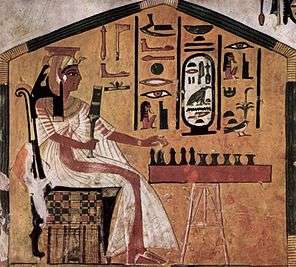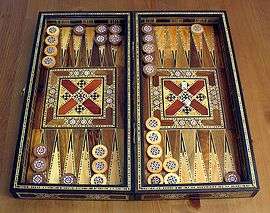Senet
|
|
Senet (or Senat[1]) is a board game from predynastic and ancient Egypt. The oldest hieroglyph representing a Senet game dates to around 3100 BC.[2] The full name of the game in Egyptian was zn.t n.t ḥˁb meaning the "game of passing".
History
| Senet in hieroglyphs | ||||
|---|---|---|---|---|
| ||||
 Painting in tomb of Egyptian Queen Nefertari (1295–1255 BC) | ||||
Senet is one of the oldest known board games. It has been found in predynastic and First Dynasty burials of Egypt,[2] c. 3500 BC and 3100 BC respectively. Senet is also featured in a painting from the tomb of Merknera (3300–2700 BC).[3] Another painting of this ancient game is from the Third Dynasty tomb of Hesy (c. 2686–2613 BC). It is also depicted in a painting in the tomb of Rashepes (c. 2500 BC).[4]
By the time of the New Kingdom in Egypt (1550–1077 BC), it had become a kind of talisman for the journey of the dead. Because of the element of luck in the game and the Egyptian belief in determinism, it was believed that a successful player was under the protection of the major gods of the national pantheon: the sun deity Ra, the wisdom deity Thoth, and sometimes the afterlife deity Osiris. Consequently, Senet boards were often placed in the grave alongside other useful objects for the dangerous journey through the afterlife, and the game is referred to in Chapter XVII of the Book of the Dead.[5]
Gameplay
The Senet gameboard is a grid of 30 squares, arranged in three rows of ten. A Senet board has two sets of pawns (at least five of each or, in some sets, more, as well as shorter games with fewer). Although details of the original game rules are a subject of some conjecture, Senet historians Timothy Kendall and R. C. Bell, respectively, have made their own reconstructions of the game.[6] Their rules have been adopted by sellers of modern Senet sets.
See also
- Mehen – another ancient Egyptian game
- Patolli – a game of pre-Columbian Mesoamerican cultures
- Royal Game of Ur – an ancient Mesopotamian game
- Tâb – a Middle Eastern game with a similar board
References
- ↑ A History of Board Games
- 1 2 In Search of the Meaning of Senet by Peter A. Piccione
- ↑ Pivotto, Carlos; et al. "Detection of Negotiation Profile and Guidance to more Collaborative Approaches through Negotiation Games" (PDF). Retrieved 2014-10-02.
- ↑ Metha, Melissa; et al. "Perancangan Permainan Media Edukasi Sebagai Pembelajaran Cara Melindungi Diri Dalam Menghadapi Bencana Aalam Bagi Anak Usia 7-12 Tahun". Retrieved 2014-10-06.
- ↑ "Egyptian Symbols: Senet". Retrieved 23 February 2016.
- ↑ Soubeyrand, Catherine. "The Game of Senet". Retrieved 2014-10-25.
Bibliography
- Crist, Walter; Anne-Elizabeth Dunn-Vaturi; Alex de Voogt (2016). Ancient Egyptians at Play: Board Games Across Borders. New York, NY: Bloomsbury. pp. 41–80. ISBN 978-1-4742-2117-7.
- Piccione, Peter A. (2007). Finkel, Irving L., ed. Ancient Board Games in perspective. London: British Museum Press. pp. 54–63. ISBN 978-0-714-11153-7.
Further reading
- Bell, R. C. (1979) [1st Pub. 1960, Oxford University Press, London]. Board and Table Games From Many Civilizations. I (Revised ed.). Dover Publications Inc. pp. 26–28. ISBN 0-671-06030-9.
- Bell, R. C. (1983). "Senat". The Boardgame Book. Exeter Books. pp. 82–83. ISBN 0-671-06030-9.
- Falkener, Edward (1961) [1892]. "§V. The Game of Senat". Games Ancient and Oriental and How to Play Them. Dover Publications Inc. pp. 63–82. ISBN 0-486-20739-0.
- Grunfeld, Frederic V. (1975). "Senat". Games of the World. Holt, Rinehart and Winston. pp. 53–55. ISBN 0-03-015261-5.
External links
| Wikimedia Commons has media related to Senet. |
- Senet at BoardGameGeek
- Senet: Review of versions rules speculation at BoardGameGeek
- Freeware Windows Senet program at SourceForge
.jpg)
